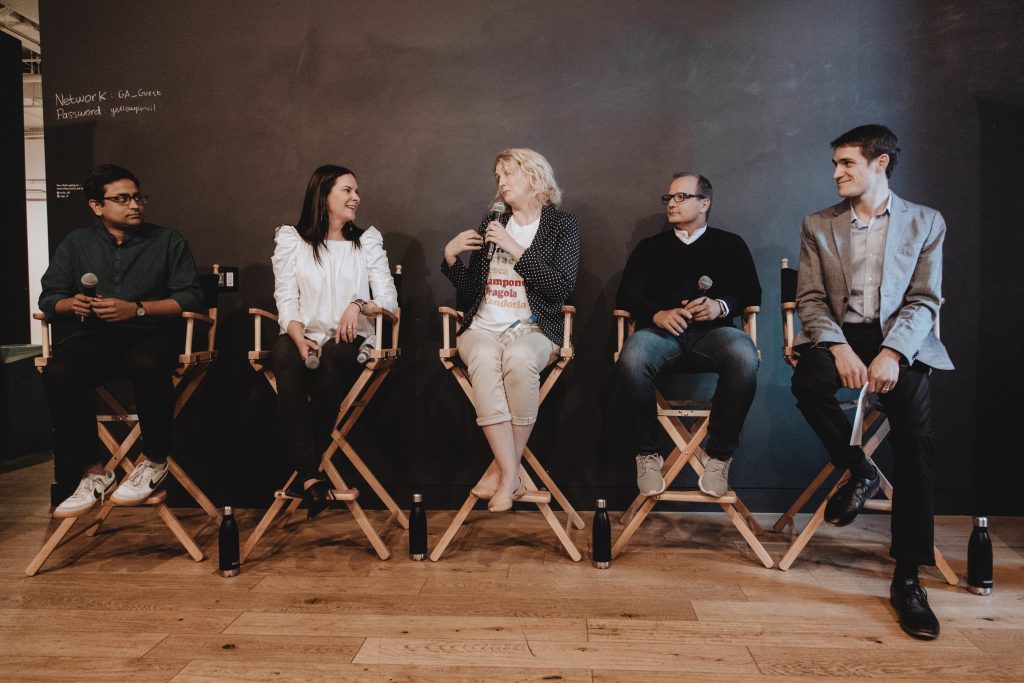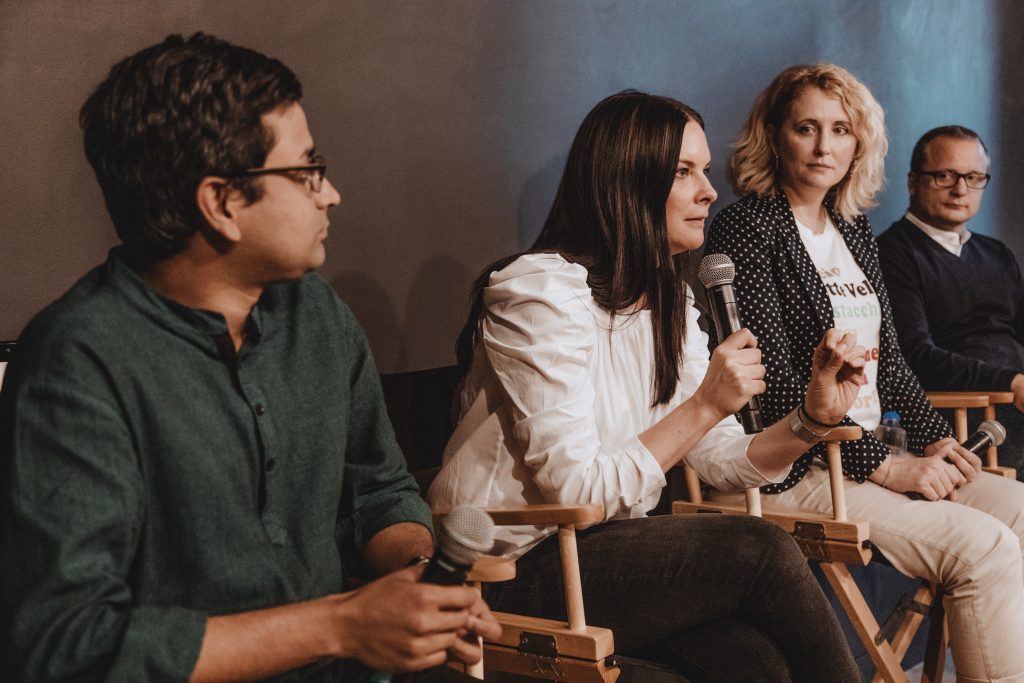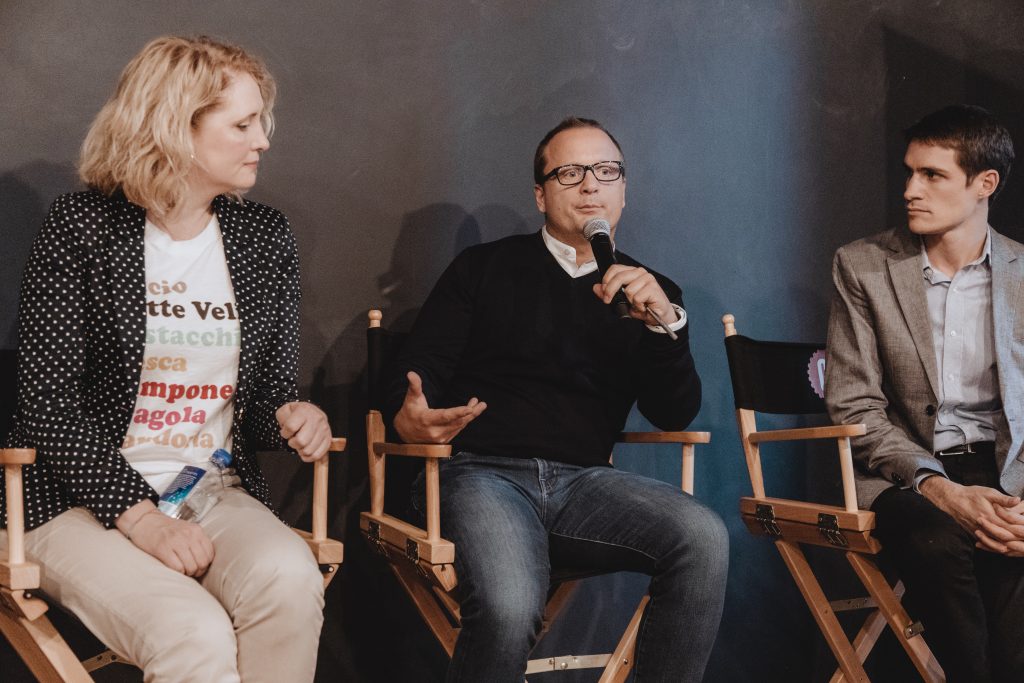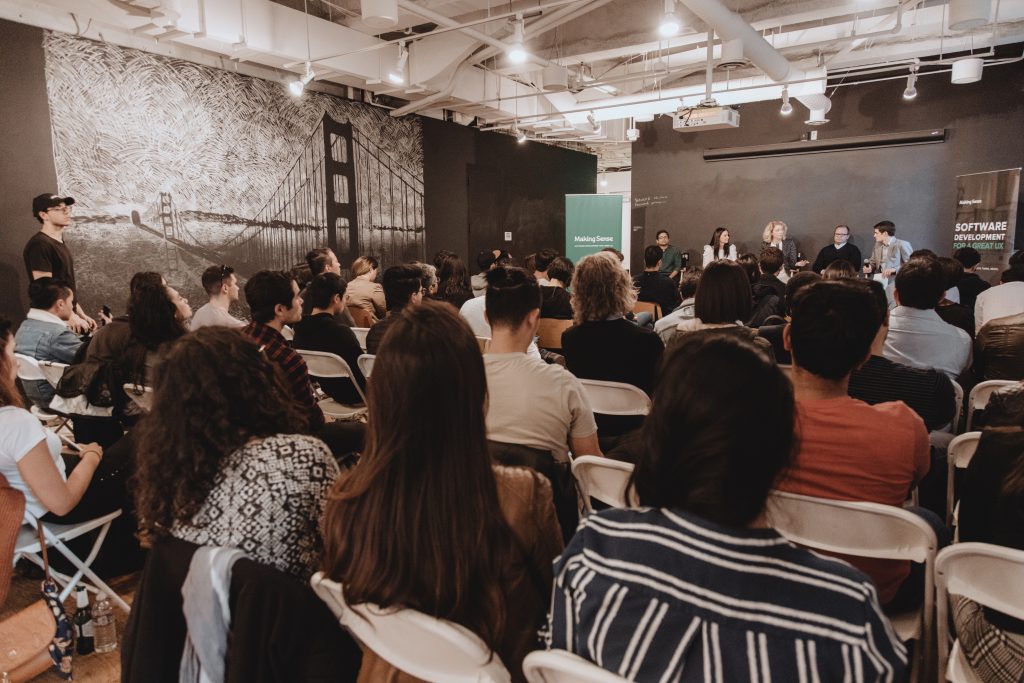One of Making Sense’s missions has been to help bring the UX community closer. Out of this central mission came the idea for holding Meetup events periodically throughout the year. This year’s theme is Intimate Sessions: Meet the Experts. Our latest was held in San Francisco and turned out to be as successful as ever. Here’s the video in case you want to take a look at it.
Meetup #2 Starts off With a Buzz of Excitement
To start with, the people at General Assembly in San Francisco were incredibly helpful, as they always are in our events and in this opportunity, they had assigned us the biggest room they have. We had an amazing panel of speakers, really! In addition, we had so many subscribers so I was eager to know how many people were going to show up.
Our panel speakers were already there, getting ready to wow the crowd that was developing.
Meet Our Distinguished Panel
Here’s who we had lined up to speak.
- Pamela Bailey, Product Design Manager at Facebook
- Stacy All, Customer Champion at Walmart
- Srikanth Jalasutram, Experience Design Lead at Uber
- Pietro Masi, UX Design Director and General Manager at Sketchin
- Fernando Florez, Head of Strategic Partnerships at Making Sense, hosted as moderator

Fernando started the discussion by asking how each panelist approached the UX Field. It was surprising to learn that they were not all UX-focused from the start. Pamela was in the Fashion Industry, Srikanth worked in the motorcycling industry, Stacy was in the arts, and only Pietro was working in a field that was anywhere close to resembling UX.
Best Pieces of Advice for UXers, From Our Panelists
Needless to say, our panel had tons of useful advice for people working in the field of UX. If you are looking to enter the UX Field or you are already in it and would like to improve, these tips might be interesting for you. How many times would you have loved the chance to know the required skills for a UX pro that Facebook or Uber is looking for? Here’s your chance. Jot down some notes on what these influential companies are looking for in a UX pro:
- Srikanth loves to see people’s work. Their works need to be intense and it should reflect their point of view.
- Pamela mentioned that it is important to see an intense curiosity. In other words, it’s important for UXers to want to learn why something is or is it not.
- Stacy added the term “scrappy”, which is the importance of continuing to work despite things going wrong.
- Pietro covered the skill side, adding that he’s usually looking for proficiency in more than one skill in order to provide that “little extra” in every project.
Let’s Dig a Little Deeper Into the User-Centric Culture
The main objective of our meetup was to learn how UX has a strong impact on the bottom line or business strategy. Creating a user-centric culture is key in every organization and in their roles, leaders have to ensure that this type of culture is 100% applied throughout their companies.
Pamela has a strong background working at Intuit and Facebook. Her take on this matter is really to understand user experience maturity at the organization. That means identifying whether decision makers understand UX as “doing something pretty” or as a “strategy killer”. Identifying this is key, and from then on, Education is the next step.

A good way to approach education is to make it a matter of spreading awareness.
Spreading Awareness of the “UX Superpowers”
Here’s how you can educate everyone in your organization about UX. Basically, you have to leverage these UX superpowers:
- Teamwork. UX is a team sport and everyone benefits from the UX Superpowers that UXers bring to the table.
- Lack of Ego. Design is not about the Designer. It’s about trying to transform collectively.
- Drive. Simply try to be tenacious in terms of continuously using your Design superpowers.
- Customer Focus. You need to understand the reality of your customers and their struggles, sensing what they need.
- Observation. Watch and learn about how customers do things in order to become more customer-focused.
- Reaching Out. Going to your customer is key, which means meeting them where they work, play, or live.
- Advocacy. As a professional, you have to become an advocate of change to the customer.
- Alignment. Sometimes alignment is something difficult to achieve. Stacy shared how she managed these challenges at Walmart. Achieving alignment means having decision makers on the same page you are. It helps to use Superpower #4, getting everyone to focus on customer needs.
- Data. “In smaller teams, one of the biggest alliances you can have is data”, added Srikanth.
- Data Analysis. “Use data to analyze what is happening and why this is happening,” commented Stacy.
- Alliances with Data Scientists. Work together with data scientists to get the most out of your data.
- Soft Skills. If you do not know how to do something, ask for someone to help you. That’s using your soft skills.
- Collaboration. UXers are all at their best when they’re part of a great creative team that thrives on a diversity of thinking and allows everyone’s opinion to be heard.
An Inclusive Approach
Multicultural users are key for the end result of your work as UX Designers. In fact, you are the necessary link between the customer’s mindset and the work that your company does.
Usually UXers design with an average person in mind. Srikanth, responsible for Inclusive Design at Uber, recommends considering the “edges”.
“If you think about your users, you start to think into the early adopters. Look at people at the edges because they are different.”
Srikanth Jalasutram, Experience Design Lead at Uber
He shared an extraordinary challenge they experienced when introducing cash into Uber’s payment methods. The whole company was against it. As an Inclusive Designer, he knew that they had to solve the problem for those people “from the edges” who wanted to pay in cash. In order to understand more about the behavior of people in each city, Uber worked with local teams, they created a prototype and took it to the CEO. The launched in just one city with one small team and now the majority of the business transactions are in cash.

Another interesting approach was Stacy’s from Walmart, where they have to design for people with low incomes, who just need to feed their families. She highlighted the importance of getting to know the user and their needs and making them feel the choice they made in their cart is the correct one. The objective was to avoid making them feel ashamed. Being aware of this type of person in any context will make a difference.
Pietro brought the concept of “Three personas” and illustrated it with an experience he had. He was designing the touch points for an oil and gas software product for people who were illiterate. How do you design for an illiterate person? That’s when the “third persona” comes in.
When it comes to teams, hiring diverse teams is critical because then you bring those persona “edges” into your process.
The number one barrier when going global is who to scale. Pamela explained that at Intuit they used to say: “Build global, but feel local”, which dovetails nicely with the concept of the Inclusive Approach.
Innovation in The Most Innovative Companies
“Innovation is a big and sexy word, but it can be very tempting.” – Pamela, Head of Product Design at Facebook.
The key for her is to ask yourself what meaningful change can I do for this experience to be better?
Innovation for her is a team sport. You should ensure that as a team, you dig into problems, fall in love with them, and solve them together in order to make a difference to your customers.
Stacy defines innovation as looking at a problem through another lens, where you’re talking to different people that could help you really feel that problem.
Professionals Fail, Too
At this point, I highly recommend that if you did not take a look at the video, do it now! There are so many good examples and it really humanizes these pros.
Failure is an amazing teacher and we all make mistakes — even Pamela at Intuit when they killed a feature thinking nobody used it! It was a very unfortunate change.
Data is your friend and the combination of quantity and quality is a beautiful thing.
“Data is your friend and the combination of quantity and quality is a beautiful thing.”
Pamela Bailey, Product Design Manager at Facebook
She learned so much in terms of running teams and tackling the next set of challenges. She also provided many tools that leaders have at their disposal.

Srikanth also regards this concept of inclusiveness. He believes that success depends on whether you are “in it” with anyone else. If you are doing this with a group of people, it is so much less painful. This is especially true in Design, where the more people you share your work with, the more likely it is that they might have something you didn’t catch. The longer you sit by yourself trying to solve a problem, the harder it becomes.
It All Comes Down to People & Data
So, zooming out, our excellent panel of UX leaders have given us a few basic takeaways. People from the audience had lots of questions and the panel answer in an extraordinary way.
In general, it seems they all agree on these concepts for people in UX to follow:
Make friends. Educate. Don’t make assumptions. Appreciate diversity. Focus on the customer. Validate your ideas with data.
Making friends means getting to know users, aligning with your clients, and having an open mind about each person you’re dealing with (whether it’s a customer, a stakeholder, or a teammate). It also means tapping into the knowledge of your peers.
Educating means spreading awareness via the list of UX Superpowers listed above.
Assumptions about users, customers, and teammates means you’re limiting the quality of your processes and your products. When you make assumptions, you’re also missing problems that you don’t even know are there — problems that you should be solving.
Diversity means openness to different experiences, different users, different ideas, and more, which leads to a better global product.
Customer-focus was explained above, and also helps you understand the product you’re developing.
Finally, data is important in every way and in every step of the development process. Hope that helps!
Keep in Touch for the Next Meetup in 2019!
Have you attended any of the Making Sense meetups yet? They’re fantastic! Stay in touch with us and stay in the know by visiting back here regularly. Who knows? Maybe we’ll see you at Meetup #3. In the meantime, you can take a look at our pictures of this extraordinary event!
PS: Special thanks to our panel of experts, they were great and provide us with lots of valuable information. It was great to meet you and I thinks that your experiences were very inspiring for all of us :)

